Paul Bishop's Blog, page 43
August 18, 2015
THE LITERARY RUNNER
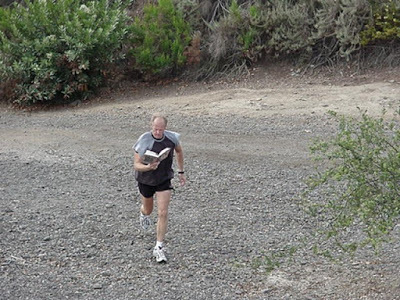 In the pursuit of speed and endurance we often subscribe to running magazines or peruse training manuals. For inspiration, we can turn to the many available books on popular races or exceptional athletes. However, for running junkies like myself, who get their motivational fix from fiction, quality running novels – actually, any running novels – can be hard to find.
In the pursuit of speed and endurance we often subscribe to running magazines or peruse training manuals. For inspiration, we can turn to the many available books on popular races or exceptional athletes. However, for running junkies like myself, who get their motivational fix from fiction, quality running novels – actually, any running novels – can be hard to find.With the demands on everyone’s schedules, time to read can be as elusive as the running novels themselves. So, before wasting time reading bad books, we should examine how the available titles stack up as competitors.
THE FRONT RUNNERS
Recognizable marquee names include John Parker's Once a Runner, Dan Middleman’s Pain, Brian Glanville's The Olympian, Bruce Tuckman's Long Road to Boston, and the dark horse entry – Loneliness of the Long Distance Runner by Alan Siltoe.
The story of college miler Quenton Cassidy, Once a Runner is considered the preeminent running novel. The writing is eloquent, presenting deep insight such as, “…running to him was real…the way he did it, the realest thing he knew. It was all joy and woe, hard as a diamond; it made him weary beyond comprehension. But it also made him free.” The reputation of Once a Runner has been established through word of mouth. Battered copies are often handed from runner to runner to runner, which does little for the author's royalty statements, but testifies to the power of his creation.
The one area Once a Runner glosses over is the head-banging edge of modern college life. This experience is better served in the lesser known Pain, written by 10,000 meter and Olympic athlete Dan Middleman. Paincovers much of the same ground as Parker’s book, but in a much more irreverent, R-rated, and finally darker manner – a portrayal possibly closer to the truth for many collegiate athletes.
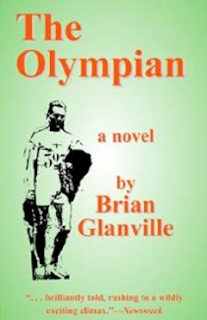 Also insightful, but characteristically snobbish in its approach, Brian Glandville’s The Olympian is a solid race entry. Glanville's highbrow writing, more often connected with the soccer world, takes us into the world of British athletics as long shot Ike Low prepares for the Olympic marathon.
Also insightful, but characteristically snobbish in its approach, Brian Glandville’s The Olympian is a solid race entry. Glanville's highbrow writing, more often connected with the soccer world, takes us into the world of British athletics as long shot Ike Low prepares for the Olympic marathon.First published in 1969, the novel is a Faustian tale filled with brutal training techniques and the type of tortuous race expected as the finale of a running novel. The greatest strength of The Olympian, however, is its dissection of the relationship between Ike Low and his coach, Sam Dee. As with its Big Race finish, The Olympian’s runner/coach relationship provides an often copied template seen even in films such as Chariots of Fire.
Another long shot marathoner is the focus of Bruce Tuckman’s Long Road to Boston. Locating a copy of this novel is the bibliophile's version of Heartbreak Hill, but it is certainly worthwhile. Tuckman's love of running imbues his writing with the same sense of physical effort and interior mysticism found in Once a Runner.
Tuckman’s main character, Bradley Townes, is a former Olympic caliber swimmer trying to mentally obliterate a major life disaster. He is a driven mass of guilt and grief, and is using his obsession to run Boston as a form of exorcism (having run Boston myself, I know this obsession well). The transformation Townes is seeking, however, demands he not only run, but also win (which certainly didn’t happen in my case – and to be clear, not even close). Told in alternating scenes of the race and flashbacks, Tuckman intertwines real runners into the story, adding a certain reality missing from many other running tales.
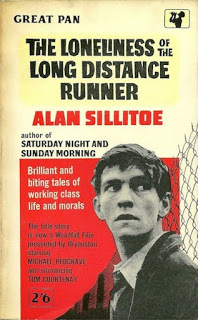 While the focus on the physical demands of a runner’s exterior life can be fascinating, it is a runner's interior life where the more interesting drama often takes place. This internal battle – the mental war with self – is notoriously hard to capture, but in Alan Siltoe's seminal Loneliness of the Long Distance Runner it is portrayed with incredible skill.
While the focus on the physical demands of a runner’s exterior life can be fascinating, it is a runner's interior life where the more interesting drama often takes place. This internal battle – the mental war with self – is notoriously hard to capture, but in Alan Siltoe's seminal Loneliness of the Long Distance Runner it is portrayed with incredible skill. Sent to an inhumane English reformatory for committing a burglary, the novel’s main character, Smith, is an extraordinary runner with major anti-social behavior patterns. The novel's final haunting, futile, and infuriating scenes leave the strongest impression of any writing in running fiction. Once read, Loneliness of the Long Distance Runner is never forgotten. Instead, it lingers in the subconscious, your inner Smith waiting to emerge whenever the stresses of life gang up on you.
THE CHALLENGERS
The second tier of running novels consists of some good efforts. Best known as a consultant on the film Chariots of Fire and a coach of the British Olympic team, Tom McNab’s first novel Flanagan’s Run is a sprawling epic of heroic proportions. Set in the 1930’s, and based on an actual 1929 Trans-America footrace, Flanagan’s Run follows a diverse group of runners as they suffer the physical and mental anguish of the ordeal – 3,000 miles for $30,000, fifty miles a day…day after day after day.
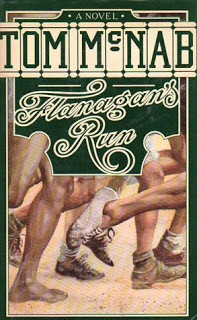 Flanagan, a P.T. Barnum-like character, is the unflappable promoter of the race who has as much to win or lose as any of the competitors. While McNab gets the running aspects exactly right, Flanagan’s Run misses the first tier of running novels as soap opera elements dominate major parts of the book. Lively and readable, Flanagan’s Run, is the most commercially successful running novel, reaching a mainstream audience with its blockbuster appeal.
Flanagan, a P.T. Barnum-like character, is the unflappable promoter of the race who has as much to win or lose as any of the competitors. While McNab gets the running aspects exactly right, Flanagan’s Run misses the first tier of running novels as soap opera elements dominate major parts of the book. Lively and readable, Flanagan’s Run, is the most commercially successful running novel, reaching a mainstream audience with its blockbuster appeal.More focused on running, but lacking the depth of Flanagan’s Run, Mark Kram’s Miles to Go follows three international runners as they prepare to set a record shattering pace in the 1983 Boston Marathon. The runners, American, Japanese, and East German, share a history of animosity driving them to huge physical and personal sacrifices.
Like many running novels, Miles to Go leads up to the Big Race. The training sequences along the way are mildly interesting, and the interplay among the runners well designed. But while the action in the Big Race is the best written sequence, the thought of runners in 1983 breaking the two hour marathon barrier – especially in Boston – is enough the blow apart a knowledgeable reader’s suspension of disbelief.
The marathon is again the focus in Huge Atkinson’s The Games. Another blockbuster-style novel with all the associated pitfalls. The Games is again the story of three runners (this seems to be the magic number) preparing to do battle in a marathon, this time at the Spain (!) Olympics. Scott Reynolds is the American running at the risk of his own life. Sunny Pintubi is an Australian aborigine with the gift of speed, but a naïve target for ruthless promoters. Harry Hayes is a quite English runner torn between loyalty and love.
Yes, all the clichés are here mixed together in a readable recipe borrowed from the many other running novels that established the clichés. Not a bad book, but nothing exceptional to break it away from the pack.
THE SPRINTERS
While marathoners and milers get the most attention in running fiction, there have been several forays into the drama of the sprint.
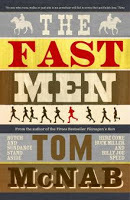 Not quite up to the standard of his first novel Flanagan’s Run, Fast Men by Tom McNab is notable for creating a new fiction genre – the sports western. In the 19th century West, fleet-footed con-men Billy Joe Speed (creator of the kangaroo start) and Buck Miller (proponent of the English Method of training – purging, sweating, and a diet of beef and ale) make their way from Kansas City to Mexico establishing their reputation for speed – not with their guns, but with their feet. The duo take on local champions in feats of pedestrianism. They never cheat at racing, but they aren’t above hiding their true identities from opposing bettors and runners.
Not quite up to the standard of his first novel Flanagan’s Run, Fast Men by Tom McNab is notable for creating a new fiction genre – the sports western. In the 19th century West, fleet-footed con-men Billy Joe Speed (creator of the kangaroo start) and Buck Miller (proponent of the English Method of training – purging, sweating, and a diet of beef and ale) make their way from Kansas City to Mexico establishing their reputation for speed – not with their guns, but with their feet. The duo take on local champions in feats of pedestrianism. They never cheat at racing, but they aren’t above hiding their true identities from opposing bettors and runners.With coverage of a world-record sprint in England, a climatic men-and-horses competition in 1878 Arizona, and its focus on running’s physical and psychological warfare, Fast Men is the most unusual of running novels – Chariots of Fire meets The Sting via Butch Cassidy and the Sundance Kid.
In a more traditional vein, Split Seconds - Tales of the Cinder Trackby Jackson Scholz is a collection of sprinting stories loosely connected by the character of a wise, but unnamed track coach at a mid-western university. Published in 1927, the stories are timeless in their positive portrayals of running and sportsmanship.
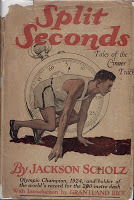 An Olympic gold medalist in Paris in 1924 (captured peripherally in Chariots of Fire), Scholz is the only sprinter in history to compete in the final events of three consecutive Olympics (1920, 1924, and 1928). He raced all over the world before turning to sports writing for a major metropolitan daily. He wrote over three hundred short stories for the sports pulps of the 30’s and 40’s, many of them about track. Of his over thirty young adult sports novels, Split Seconds is the only track title among the football and baseball stories that were his specialty.
An Olympic gold medalist in Paris in 1924 (captured peripherally in Chariots of Fire), Scholz is the only sprinter in history to compete in the final events of three consecutive Olympics (1920, 1924, and 1928). He raced all over the world before turning to sports writing for a major metropolitan daily. He wrote over three hundred short stories for the sports pulps of the 30’s and 40’s, many of them about track. Of his over thirty young adult sports novels, Split Seconds is the only track title among the football and baseball stories that were his specialty.Split Secondsbegins with the story of the Winning Bug, which has been anthologized more often than any other track story. However, The Booby Squad, in which a young sportsman trains the general physical education class to take on the varsity track team, is actually much more fun and inspiring.
THE CHEATERS
Unlike many other sports, running presents limited clever opportunities to use cheating as fictional fodder. There are two novels, however, which use the dark side of performance enhancing in a satisfying fashion.
When Golden Girl was written in 1977 by Peter Lovesy (under his pseudonym Peter Lear), its use of human growth hormones to help create and package an American Olympic superwoman was ahead of the curve. At the time, HGH was not a banned substance, and athletes were not tested for usage despite its dangerous side effects. The book, was ultimately derailed by the American boycott of the Moscow Olympics in 1980, the setting for the story. The boycott also killed the feature film, best remembered for Susan Anton as the classic Golden Girl, dooming it to occasional appearances on late night television.
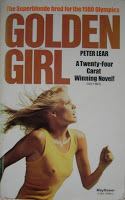 Prophetic in tone and consequence, Golden Girl has recently been reissued with a short, but insightful introduction by the author. Read with hindsight, the novel’s cautionary tale is outdated, yet still remains an intriguing slice of running science fiction.
Prophetic in tone and consequence, Golden Girl has recently been reissued with a short, but insightful introduction by the author. Read with hindsight, the novel’s cautionary tale is outdated, yet still remains an intriguing slice of running science fiction.Another novel centers on a questionable performance enhancing system possibly still in current use. Runner’s Blood by James J. Fischer is a fascinating expose of the lengths athletes, coaches, and countries are willing to go to ensure victory. A serious recreational runner and cyclist, Fischer based his plot on discoveries made in his own laboratory while researching cancer cures. Produced by a very small publisher, the book needed an editor with a sharp blue pencil who could have cut the manuscript by a third to keep the story moving. Despite this flaw, the science in Runner’s Blood has the ring of reality provided by the author’s expert background. This authority makes up for the slow pace, which turns the story from a middle distance read into a marathon.
Golden Girl and Runner’s Blood both bring a unique layer of depth to their storyline. For a change these novels go beyond the Big Race finish of most running fiction. As such, they deserve a readership.
THE RELATIVE NEWCOMERS
Then there are four relative newcomers to keep the field on its toes.
Sharp writing and real insight give Life at These Speeds by Jeremy Jackson a definite edge on the competition. Star 800 meter runner and golden boy Kevin Shuler rides home with his parents after a local track meet. Following behind on the team bus, his entire track team is wiped out in a traffic accident. Numb with loss, Kevin suddenly changes from running star to running phenom as his single minded obsession with being perfect threatens to destroy him. A knock-your-socks-off book as much about the quest to be a runner as it is about the cost of being human.
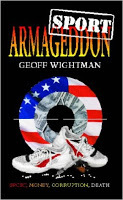 For something completely different try Geoff Wightman’s Sports Armageddon. Carrying review quotes from running stars Paula Radcliffe and Sebastian Coe, Sports Armageddon is a timely look at running crossed with the hype of reality television. This tale of a junk sport endurance event gone very bad requires participants to swim Lake Okeechobee in Central Florida, then cycle around the state before running from Jacksonville to Atlanta. It is a harrowing page turner of murderous competitors and television ratings driven by the constant threat of death.
For something completely different try Geoff Wightman’s Sports Armageddon. Carrying review quotes from running stars Paula Radcliffe and Sebastian Coe, Sports Armageddon is a timely look at running crossed with the hype of reality television. This tale of a junk sport endurance event gone very bad requires participants to swim Lake Okeechobee in Central Florida, then cycle around the state before running from Jacksonville to Atlanta. It is a harrowing page turner of murderous competitors and television ratings driven by the constant threat of death. Robert Kellogg’s Murder on the Run is a lighthearted look at a group of Hash House Harriers involved with exotic poisons and murder and bizarre sex. The portrayal of the harriers and their antics is affectionate and funny, making you wish the murder plot had been left on the editor’s desk.
Robert Douglas Spetta gives us another outsider in High Tide, Low Moon Running. Against the backdrop of the Big Race, the story of the main character’s life unfolds in flashbacks as he seeks new direction through training and running marathons. A first novel with the usual flaws, High Tide, Low Moon Runningdoes hold the promise of the writer running a better novel length race in the future
RUNNING FICTION’S CURIOSITIES
In every major race there are always a few runners dressed up in silly costumes to support political agendas, university japes, or to boost their flagging egos with momentary attention. Running fiction also has its share of these flashy curiosities.
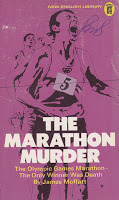 The Marathon Murder, by once renowned paperback hack James Moffatt, began when he was challenged, on a late night English television show in 1972, to back up the claim he could write a book in a week. The talk show provided the opening line for the novel, and Moffatt wrote the first paragraph on live TV. Seven days later, he delivered the manuscript to the publishers. In another two weeks, the novel was selling briskly over British bookshop counters. While the story hook is serviceable, the slim volume suffers from Moffatt’s lack of knowledge regarding training, racing, marathons, and any other aspect of running. Moffatt completed his task of producing a book in a week. The challenge, however, should have been to produce a good book in a week.
The Marathon Murder, by once renowned paperback hack James Moffatt, began when he was challenged, on a late night English television show in 1972, to back up the claim he could write a book in a week. The talk show provided the opening line for the novel, and Moffatt wrote the first paragraph on live TV. Seven days later, he delivered the manuscript to the publishers. In another two weeks, the novel was selling briskly over British bookshop counters. While the story hook is serviceable, the slim volume suffers from Moffatt’s lack of knowledge regarding training, racing, marathons, and any other aspect of running. Moffatt completed his task of producing a book in a week. The challenge, however, should have been to produce a good book in a week.While The Marathon Murder is a passing curiosity at best, The Truth About Wilson is the most unique curiosity in running fiction. It features the first superhero track star, and while totally unbelievable, its sense of tongue-in-cheek fun makes it an outstanding addition to running fiction.
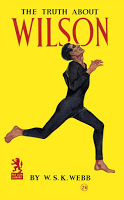 Unlike Spider-manand The Hulk, The Truth About Wilson won’t be a summer blockbuster anytime soon. In 1943 England, however, Wilson, The Man in Black, was the stuff of legends. In the midst of a war with Germany, any British sporting victory was considered a morale booster, even if it took place in the pages of The Wizard, a boy’s adventure broadsheet.Any champion runner would have been cause for celebration, but a mystery man who lived secretly on the Yorkshire Moors, was reputed to be 150 years old, and shattered athletic records all over the world like cheap crockery, was a major sensation.
Unlike Spider-manand The Hulk, The Truth About Wilson won’t be a summer blockbuster anytime soon. In 1943 England, however, Wilson, The Man in Black, was the stuff of legends. In the midst of a war with Germany, any British sporting victory was considered a morale booster, even if it took place in the pages of The Wizard, a boy’s adventure broadsheet.Any champion runner would have been cause for celebration, but a mystery man who lived secretly on the Yorkshire Moors, was reputed to be 150 years old, and shattered athletic records all over the world like cheap crockery, was a major sensation. A slight, wiry figure in an old fashioned, black running costume that would be very stylish today, Wilson appeared out of nowhere to run races, participate in track events, and generally defend the standards of the British Empire against all-comers. At the end of whatever record crushing track event he completed, Wilson would virtually collapse before slinking off to again rejuvenate himself secretly on the vast English moors.
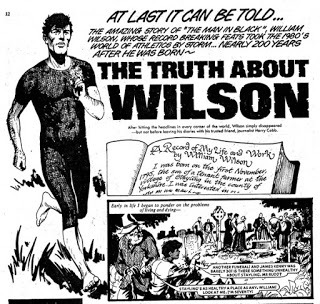 The Wilson saga began as a short story serial in The Wizard, later making the transformation to illustrated comic strips. A fascinating collection of the serialized stories was produced in paperback in the 60’s under the title The Truth About Wilson by W.S.K. Webb. Hard to find, The Truth About Wilson is a true collector’s treasure.
The Wilson saga began as a short story serial in The Wizard, later making the transformation to illustrated comic strips. A fascinating collection of the serialized stories was produced in paperback in the 60’s under the title The Truth About Wilson by W.S.K. Webb. Hard to find, The Truth About Wilson is a true collector’s treasure. From the 40’s through the 70’s, British comics Rover and Victor also carried stories about a track star. Alf Tupper – The Tough of the Track was not a super hero like Wilson. Instead, Tupper was a poverty level working lad who ate fish and chips and could run the legs off of any toffee-nosed opponent from the privileged class.
Similarly to Wilson, Alf’s adventures were first serialized short stories before transforming to illustrated comic strips. Alf’s stories, however, were never collected in book form. To check out episodes of Alf’s or Wilson’s adventures hop on the web at www.britishcomics.20m.com/
THE REST OF THE PACK
Rounding out the field of running novels are a scattering of lesser known running titles of questionable quality. The best of the bunch is The Other Kingdomby Victor Price. The story of struggling Irish miler Colin Wornock, the story is hampered by far ranging musings on the nature of heroism and overcoming yourself.
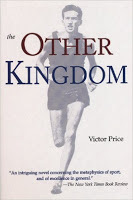 Author Paul Christman throws women runners into the mix in Purple Runner, as a New Zealand woman marathoner tries to shake off her baggage of never finishing quite high enough in a race. Involving herself with a facially disfigured male marathoner, whose workouts would put the fittest Kenyan to shame, the woman trains madly as both characters aim toward the Big Race climax at the London Marathon.
Author Paul Christman throws women runners into the mix in Purple Runner, as a New Zealand woman marathoner tries to shake off her baggage of never finishing quite high enough in a race. Involving herself with a facially disfigured male marathoner, whose workouts would put the fittest Kenyan to shame, the woman trains madly as both characters aim toward the Big Race climax at the London Marathon.In The Long Run by Tim Van Wagoner gives us a somewhat successful running as metaphysical journeystory. Josh Chamberlain is the great-great-grandson of an acclaimed Civil War hero. As Josh prepares to run his first 26.2 miler, the Marine Corps Marathon in Washington D.C., he finds himself getting into the zone.
In this metaphysical state, brought on by the classic endurance test, Josh communes with his Civil War ancestor and contemplates the meaning of life and love. Notable for its portrayal of small town America, In The Long Run doesn’t quite pull off its triple act as a contemporary running story, a historical novel, and a love story. It would have done better concentrating on one event.
Though Tom McNab scored with both Flanagan’s Run and Fast Men, his third running novel, Rings of Sand, squanders its premise on characters nobody cares about. Attempting to hijack the 1984 Los Angeles Olympics by creating a professional Olympics backed by Arab oil money to be held at the same time, is an interesting topic for sports column commentary, but tough for something novel length. Unfortunately, McNab gets so busy trying to fill the holes in his concocted plot, he forgets what made his other books special – the running.
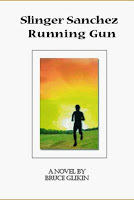 A women runner also figures in Jeffrey Recker’s first novel, Chasing the Bear. Jennifer Ledge, a fresh from college competitive runner, rambles all over the place in the first person narrative. This creates a lack of focus in the novel that even the page zipping ending, can’t rescue.
A women runner also figures in Jeffrey Recker’s first novel, Chasing the Bear. Jennifer Ledge, a fresh from college competitive runner, rambles all over the place in the first person narrative. This creates a lack of focus in the novel that even the page zipping ending, can’t rescue.Slinger Sanchez Running Gun by Bruce Glikin should be commended for taking on racism and family abuse issues against the backdrop of Jesse Sanchez’s attempt to become a top 800 meter runner. Unfortunately, far-fetched athletic performances, a men’s magazine romance, and several the political plotlines turn the story from a sprint into a never ending steeplechase over an unmarked, potholed course.
FINAL KICK
There may be a running novel or two that didn’t make it to the starting line here, but they obviously weren’t ready for the competition. For those of you wanting a wider sample of many of the above stories, check out The Runner’s Literary Companion by Garth Battista. The collection is comprised of twenty-four running short stories/novel excerpts and a selection of running inspired poetry. It is a great way to find an author or a novel you want to explore further.
Okay, running fiction junkies, get your checklists ready and put on your racing shoes. It’s time to hit the new, used, and cyberspace book stores for titles and tales. Unlike drinking and driving, running and reading do mix. So, enjoy, but be sure to watch where you’re going.
ABOUT THE AUTHOR: Novelist, screenwriter, and television personality, Paul Bishop spent 35 years with the Los Angeles Police Department, where he was twice honored as Detective of the Year. He continues to work privately as a deception expert. His fifteen novels include five in his LAPD Homicide Detective Fey Croaker series. His latest novel, Lie Catchers, begins a new series featuring top LAPD interrogators Ray Pagan and Calamity Jane Randall. www.paulbishopbooks.com , www.fightcardbooks.com , Twitter @bishsbeat , Facebook , Amazon
Published on August 18, 2015 13:51
August 15, 2015
MURDER AND MISS FISHER ~ PART II
 I’m going to need you to be patient with me as this post is going to ramble a little, but I’ll eventually get to the point…
I’m going to need you to be patient with me as this post is going to ramble a little, but I’ll eventually get to the point…Recently, I put up a blog post applauding the joys of the Australian television show, The Miss Fisher Murder Mysteries(currently streaming on Netflix) and the series of books by author Kerry Greenwood on which the excellent series, set in 1920s Australia, is based. After linking the post to various social networks, I figured it might generate a few likes and maybe a couple of brief comments. However, as soon as the post went up a strange phenomenon began to occur – the post was generating an inordinate number of likes and – more specifically – an unusual number of enthusiastic comments.
But here’s where things got even more strange – the comments were 100% from men. I’m talking guys who almost all make a living (or at least a hardscrabble existence) writing over the top men’s action fiction. And, not only were these macho skewing knuckle-draggers leaving comments, but all of them started their comment with some version of, “I love this show!”
Now, most comments on social networks would stop there – a brief declaration and nothing more. But these comments went on to enthuse about where they watched the show, how good the sets and production values were and (knock me over with a feather boa) how amazing the clothes were.
Huh?
My world view was shaken. Not one of the guys said, “My wife loves this show,” or “I have to watch this with my girlfriend or I don’t get lucky.” Those female entities didn’t even get a mention. The men commenting were very specific – “I love this show!”
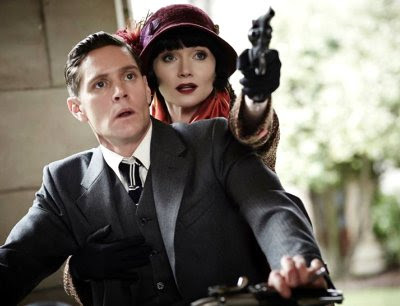
Frankly, even though I had enthused myself about the show and the books, if pinned down, I would have categorized The Miss Fisher Murder Mysteries as targeted mostly toward a female audience. A liberated, empowered, female audience, perhaps, but certainly not a show to spark overt enthusiasm (if not adoration) from normally hairy-chested, reluctantly communicative males. This is not intended as a slur of any kind, just an observation based on knowing the viewership stats of other similarly themed shows.
So what was up with this outpouring of testosterone fueled love?
While the show’s sets, period costumes, and production values get mentioned, I believe the true male appeal is the actual character of Miss Phyrne (pronounced Fry-nee) Fisher and the way the character is completely embodied by actress Essie Davis.
I’m not talking about physical appeal here – although the character and the actress definitely outshine all the gym sculpted, liposuctioned, boob-jobbed, twenty-something actresses who dominate American television. What I’m talking about is the actual character traits with which author Kerry Greenwood imbued her creation, and which is brilliantly embodied by Essie Davis.
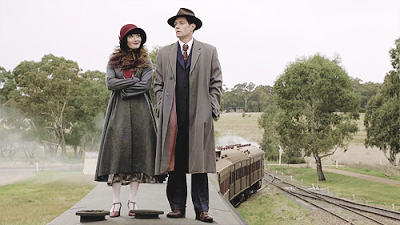 Okay, here is where we ramble…
Okay, here is where we ramble…Novels and scripts are two completely different animals. When a novel has been acquired for television, too often the ego driven producers and show runners feel the overwhelming need to put their own stamp on the property. This is rarely a good thing. This process almost always leads to burying all the things that made the character and novel special under an avalanche of second best, third best, and fourth best ideas – all depending on how many cooks are in the mix.
In the case of The Miss Fisher Murder Mysteries the two producers, Deb Cox and Fiona Eagger, clearly worked painstakingly with author Kerry Greenwood to get the character of Miss Fisher as close to the original source as possible – even adapting many of the episodes directly from the book series.
The changes the producers found necessary to adapt the books to the medium of television were judiciously undertaken. Everything that made the character and books special was preserved as much as the translation from one medium to another would allow. But all of this could have been for naught if the casting of both lead and secondary actors wasn’t exactly right – miscasting being a quicksand quagmire too deep and binding to escape.
In actress Essie Davis, however, the casting director got it exactly right. Both fans of the books and fans of the show can imagine anyone else in the role. Essie Davis isPhryne Fisher.
But the perfect casting for The Miss Fisher Murder Mysteries goes well beyond its lead actress, extending to even the most minor of secondary roles. To a person, the cast is excellent, and seem to know they have been involved in creating something special.
Still, even with all of this effort and creative business taken into consideration, I’m in no doubt, it is specifically the character traits of Phryne Fisher that makes the show so appealing to a male audience.
Author Kerry Greenwood has stated that in Phryne Fisher, she wanted to create a female version of the Saint. An admirable goal, she has mostly achieved, yet still short of the Saint’s iconic status.

However, like Simon Templar, Phryne has a larcenous heart and a reckless streak tempered only by a complete confidence in her abilities. This is not the obnoxious, blind or silly confidence given to many female characters. Instead, like the Saint, Phryne has earned her confidence the hard way.
She drives a Hispano Suiza very fast. When she’s not wing walking, she flies planes with acrobatic abandon. She takes lovers as she chooses, while always remaining in control of her emotions and responsibility for avoiding natural consequences – she bluntly states she doesn’t like children and has no intention of becoming a mother.
Raised in grinding poverty in Australia, Phryne’s life changed when several unexpected natural deaths in England bestowed on her father a title, lands, a manor house with extensive grounds, and a huge fortune. While all of this backstory is only briefly touched upon, it gives credence to how Phryne’s character developed during the years she spent learning and earning her skills across Europe and, specifically, in the Apache Quarter of Paris.
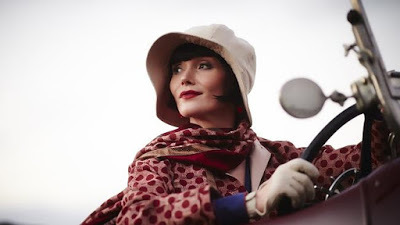 This background also explains her ability to relate to the lower classes, and to bring out their loyalty and best efforts. She easily wins both admiration for the actions and despair for her safety from all those whom she befriends. But the key is, Phryne is sincere and loyal right back. Lashing of ready cash also help to lubricate situations when loyalty and friendship isn’t enough.
This background also explains her ability to relate to the lower classes, and to bring out their loyalty and best efforts. She easily wins both admiration for the actions and despair for her safety from all those whom she befriends. But the key is, Phryne is sincere and loyal right back. Lashing of ready cash also help to lubricate situations when loyalty and friendship isn’t enough.Gun competent, knife fighter, knowledge of poisons, self-sufficient, fearless, determined, suave, and cool under pressure, Phryne Fisher is the Modesty Blaise of the 1920’s. She is everything any guy who grew up on James Bond and the Saint wants to be – except she’s female.
But not just female…
She maybe fictional, but what reader doesn't long for certain fictional characters to be real – Mr. Darcy anyone? She's more than the ideaslized best friend, Phryne Fisher is female with a wink and a smile all wrapped in a conspiratorial attitude of promise and possible attainability – if you behave yourself.
She can talk cars, talk planes, and drink you under the table. If you were arrested, she wouldn’t just go your bail, she’d be in handcuffs next to you saying, “Damn, that was fun!”
I think the truth is, every guy who says, “I love this show,” when referring to The Miss Fisher Murder Mysteries, is actually declaring their love for Phryne herself – an everygirl with panache.
Published on August 15, 2015 08:26
August 14, 2015
BOLO: PUBLIC MORALS

Be On The Lookout: With the retro look of the late lamented Crime Story and Mad Men, Public Morals is a new cop show from TNT from executive producer Steven Spielberg and Amblin Television, starring Mob City’s Ed Burns. If the preview below is anything to go by, it certainly looks worth checking out.
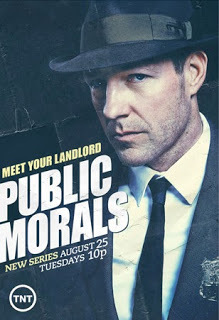 New York Police Department – 1967
New York Police Department – 1967Public Moralscenters on the NYPD’s Public Morals Division, where cops walk the line between morality and criminality while sometimes giving in to the temptations of dealing with every kind of vice. The heart of Public Morals is Terry Muldoon (Burns), a tough cop who knows the line between the good guys and bad guys is very thin. He is also determined to raise his sons to be honest and hardworking as he deals with the dark underbelly of the vice world.Things are going to go BOOM!
Published on August 14, 2015 16:12
U.N.C.L.E. REIMAGINED
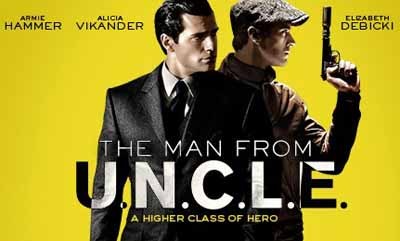 My fellow U.N.C.L.E. fan, Warner Todd Huston, posted a great recap of U.N.C.L.E. history and a non-spoiler review of the new big screen reimagining of The Man From U.N.C.L.E. by director Guy Ritchie, which I think says it all. With his permission, I’m reposting it here...
My fellow U.N.C.L.E. fan, Warner Todd Huston, posted a great recap of U.N.C.L.E. history and a non-spoiler review of the new big screen reimagining of The Man From U.N.C.L.E. by director Guy Ritchie, which I think says it all. With his permission, I’m reposting it here...Review: Guy Ritchie’s Man From U.N.C.L.E.
Warner Todd Huston
The classic 1960s TV show that barely escaped being canceled after its first season yet rose to a level of popularity that rivaled that of The Beatles is finally getting a big screen reimagining and many fans hope it will be successful enough to spawn sequels and a new series of movies. So, how does Guy Ritchie’s new “The Man From U.N.C.L.E.” measure up?
The History
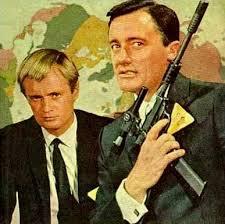 Before we get to the film, many younger viewers will be wholly unfamiliar with the source material. The original “Man From U.N.C.L.E.” TV show, staring Robert Vaughn, David McCallum, and Leo G. Carroll, debuted during the 1965 TV season and almost disappeared in a single season were it not for a spectacular PR effort. Not only was that first season in boring black and white, but it barely made a dent in the ratings meaning the show wasn’t even close to a hit during its first run episodes. But due to some brilliant rear guard public relations, during the show’s Summer reruns U.N.C.L.E. grew into a huge hit becoming one of the world’s first appointment television shows with a world-wide fan base that for a short time rivaled that of The Beatles.
Before we get to the film, many younger viewers will be wholly unfamiliar with the source material. The original “Man From U.N.C.L.E.” TV show, staring Robert Vaughn, David McCallum, and Leo G. Carroll, debuted during the 1965 TV season and almost disappeared in a single season were it not for a spectacular PR effort. Not only was that first season in boring black and white, but it barely made a dent in the ratings meaning the show wasn’t even close to a hit during its first run episodes. But due to some brilliant rear guard public relations, during the show’s Summer reruns U.N.C.L.E. grew into a huge hit becoming one of the world’s first appointment television shows with a world-wide fan base that for a short time rivaled that of The Beatles. 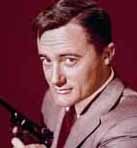 The show that pretty much programmed every spy show since its debut featured a suave, super cool American spy with the unforgettable name of Napoleon Solo (played by veteran actor Robert Vaughn). The imperturbable Solo used his brains as much as he used his brawn to solve his spy assignments. In fact, his brawn was often not much to write home about as he was knocked to the ground and tied up by the bad guys as often as he bested them in fisticuffs.
The show that pretty much programmed every spy show since its debut featured a suave, super cool American spy with the unforgettable name of Napoleon Solo (played by veteran actor Robert Vaughn). The imperturbable Solo used his brains as much as he used his brawn to solve his spy assignments. In fact, his brawn was often not much to write home about as he was knocked to the ground and tied up by the bad guys as often as he bested them in fisticuffs. 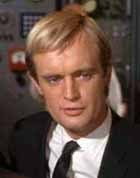 His partner, Russian super spy Illya Nickovitch Kuryakin (David McCallum, a bit of a newcomer to American audiences) was an interesting, enigmatic, sarcastic man of action who offered as much sex appeal for the ladies as he revealed embarrassment over that very appeal. Many NBC executives initially thought that the character, with his mop of blond hair and youth appeal, was a bad idea. They thought that this Russian hippy should have been gotten rid of. Some even worried that viewers would think he was gay and we can’t have gays on TV in 1965! In fact, the Illya character was initially only cast as a semi-regular character but once fans saw the chemistry between Napoleon and his pal Illya, they couldn’t get enough and Illya’s role was bumped up to co-star. Illya’s past was a bit cryptic and he was certainly never called a Soviet. The closest viewers got to learning about Illya’s personal past was when we learned that he went to the University of Georgia… not the one in the southern state but the Russian one!
His partner, Russian super spy Illya Nickovitch Kuryakin (David McCallum, a bit of a newcomer to American audiences) was an interesting, enigmatic, sarcastic man of action who offered as much sex appeal for the ladies as he revealed embarrassment over that very appeal. Many NBC executives initially thought that the character, with his mop of blond hair and youth appeal, was a bad idea. They thought that this Russian hippy should have been gotten rid of. Some even worried that viewers would think he was gay and we can’t have gays on TV in 1965! In fact, the Illya character was initially only cast as a semi-regular character but once fans saw the chemistry between Napoleon and his pal Illya, they couldn’t get enough and Illya’s role was bumped up to co-star. Illya’s past was a bit cryptic and he was certainly never called a Soviet. The closest viewers got to learning about Illya’s personal past was when we learned that he went to the University of Georgia… not the one in the southern state but the Russian one!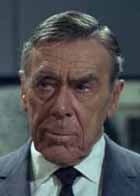 Acting as the guiding hand over this pair of super agents was their boss, Alexander Waverly, leader of U.N.C.L.E. Waverly was played by veteran actor Leo G. Carroll who brought a grandfatherly, legitimizing presence to the series.
Acting as the guiding hand over this pair of super agents was their boss, Alexander Waverly, leader of U.N.C.L.E. Waverly was played by veteran actor Leo G. Carroll who brought a grandfatherly, legitimizing presence to the series.And what of this U.N.C.L.E.? Well it was an acronym that stood for the United Network Command for Law and Enforcement, an international organization funded by all the world’s nations and its chief duty was to protect the world from the big bad organization named THRUSH. The bad guys were never fully identified in the series (though the novelizations labeled them the “Technological Hierarchy for the Removal of Undesirables and the Subjugation of Humanity”) but they were an organization with resources that rivaled that of U.N.C.L.E.’s and were its polar opposite on the evil scale. Worse than the Nazis, worse than world-wide communism, THRUSH wanted no less than to rule the world.
 The show came just as science, technology, jet airplanes, computers, and threats of nuclear war were hectoring the civilized world. Our men from U.N.C.L.E. proved to be just the ticket to forget those worries for an hour each week with humor, action, and spy gadgets galore.
The show came just as science, technology, jet airplanes, computers, and threats of nuclear war were hectoring the civilized world. Our men from U.N.C.L.E. proved to be just the ticket to forget those worries for an hour each week with humor, action, and spy gadgets galore. One of the fan’s favorite parts of the show was the spectacular, if not just a bit fantastic, UNCLE Special pistol. “The Gun” was so popular that it got its own fan mail!
One of the fan’s favorite parts of the show was the spectacular, if not just a bit fantastic, UNCLE Special pistol. “The Gun” was so popular that it got its own fan mail!As I noted, the first season wasn’t a big hit during most of the season but led by PR man Chuck Painter, during the tail of the first season’s air dates the publicity department went into overtime and stars Vaughn and McCallum went on junkets all across the country to sell the show for a second season. It was a brilliant move because as viewership began to grow, especially for the Summer re-runs, teen fan magazines, newspapers and magazines, and other TV shows began to take notice. By the launch of season two “The Man From U.N.C.L.E.” was a bona fide hit. In fact, it was not just a hit, but a cultural phenomenon. It wasn’t long before people began to notice that the USA ground to a halt during U.N.C.L.E. night!
The show was truly international, too. Set in Africa, England, Austria, and any number of countries both made up and real, the show hopped back and forth across the globe every week all thanks to the massive, decades old sets at MGM where the show was filmed. Without ever leaving the studio’s back lots U.N.C.L.E. was all at once everywhere in the world. And that reach translated into ratings abroad, too. U.N.C.L.E. wasn’t *just* an American spy show. It truly felt like the world’s spy show.
For two seasons U.N.C.L.E. was the top show on TV. Unfortunately, the show’s own producers lost touch with what made the show a hit and its third season descended into Batman-styled campy comedy. Fans began to get discouraged but many were ready for season four which, when it debuted, proved that the show was back on track and more serious as a spy show. But for the TV executives it was too little too late. Season four was canceled after only 16 episodes of the usual 30 or so.
But after its end, all at once, U.N.C.L.E. went from the most popular shows in TV history to nearly forgotten. Worse, after its cancelation, U.N.C.L.E. faced a series of particular problems that kept it mostly off the air and out of the sort of syndication that gave long life to such shows as “Lost In Space,” and most especially “Star Trek.” It wasn’t long before “Man From U.N.C.L.E.” faded to just a childhood memory for millions.
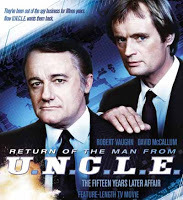 In 1983, new producers tried a reunion movie that, while the ratings were fairly good and fans generally liked it, didn’t excite the networks enough to draw an order for a new series. Rumor had it that Vaughn was up for a new series but McCallum wasn’t as enthusiastic, so even if it had been picked up, it may have been shy one of its leads.
In 1983, new producers tried a reunion movie that, while the ratings were fairly good and fans generally liked it, didn’t excite the networks enough to draw an order for a new series. Rumor had it that Vaughn was up for a new series but McCallum wasn’t as enthusiastic, so even if it had been picked up, it may have been shy one of its leads.And that leads us to 2015 and we’ve got an updated film with Guy Ritchie’s “Man From U.N.C.L.E.”
Ritchie has some big spy shoes to fill, too. After all, the germ of U.N.C.L.E. was born in the fertile mind of master spy author Ian Fleming who created James Bond.
The early U.N.C.L.E. treatment was written by Fleming, though most of his ideas were discarded when show runners Sam Rolfe and Norman Felton retooled Fleming’s ideas for what would become U.N.C.L.E. Still, without Fleming’s imprimatur, the show might not have gotten off the ground at all. One of the key Fleming aspects of the show, though, was the name Napoleon Solo which stuck almost even becoming the name of the show: “Ian Fleming’s Solo.”
Fleming, who was ill at the time and having too many other legal issues, sold the rights for “Solo” to Norman Felton for the grand sum of one pound. Felton and writer Sam Rolfe both retooled the premise and made it into what we now know as “The Man From U.N.C.L.E.”
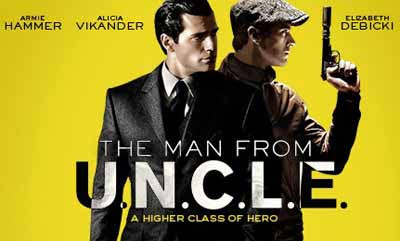 The Review
The Review
So, what of this newest version? Well, director Guy Ritchie is known for smash-bang action and hyper-kinetic movies, but in U.N.C.L.E., Ritchie seems to have made a bit more of an effort for style over kinetics and for the most part his decision was a good one.
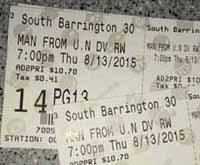 Ritchie’s U.N.C.L.E. is suave, cool, stylish, and a wonderful harkening back to the old-style 1960s spy genre. But it is also reminiscent of the good old 60s/70-s heist films and is paced just the same way in many respects. We meet the players, are introduced to the mark and his object of desire, learn the plan, then watch the heist as it unfolds. It is a harkening to the heist film even down to the split-screen effects showing the two agents simultaneously doing their various separate parts of the scheme (the split-screen effect is used sparingly here, so don’t worry if you aren’t a fan of that technique).
Ritchie’s U.N.C.L.E. is suave, cool, stylish, and a wonderful harkening back to the old-style 1960s spy genre. But it is also reminiscent of the good old 60s/70-s heist films and is paced just the same way in many respects. We meet the players, are introduced to the mark and his object of desire, learn the plan, then watch the heist as it unfolds. It is a harkening to the heist film even down to the split-screen effects showing the two agents simultaneously doing their various separate parts of the scheme (the split-screen effect is used sparingly here, so don’t worry if you aren’t a fan of that technique). ne thing is certain, this this film is not a typical, modern action flick. This isn’t the loud, obnoxious, fare we are used to seeing these days. It isn’t a frantic, Michael Bay-ish, trip filled with constant explosions, dizzying camera cuts, and million-decibel explosions with a soundtrack that hits your ears like a sledgehammer. This movie is style and grace with just enough action–and realistic action, at that–to add that level of excitement one needs in a spy flick. Ritchie also imbued this film with a great, easy going humor. It is adult humor, too. Not “adult” as in raunch or sex humor, but adult as in smart and grown up. Perhaps the best way to explain it is that it is droll. There is no slapstick, loud, guffawing humor here. The closest to guffaws we get is in how one of the bad guy dies. In any case, it works very well.
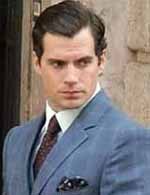 As Napoleon Solo, Henry Cavili is just as smooth and imperturbable as Robert Vaughn was. Cavill channeled the Solo mystique perfectly. Cavill’s Solo is perpetually unfruffled, smooth and always in control–even when he wasn’t… in control, I mean. Old time fans may not quite appreciate this Napoleon’s past that gets him into the spy game, but his character during the film’s time period is a perfect Man From U.N.C.L.E. characterization.
As Napoleon Solo, Henry Cavili is just as smooth and imperturbable as Robert Vaughn was. Cavill channeled the Solo mystique perfectly. Cavill’s Solo is perpetually unfruffled, smooth and always in control–even when he wasn’t… in control, I mean. Old time fans may not quite appreciate this Napoleon’s past that gets him into the spy game, but his character during the film’s time period is a perfect Man From U.N.C.L.E. characterization. Illya Kuryakin, played by Armie Hammer, is the biggest departure from the original TV character. And if old time fans might raise an eyebrow at the earlier history Ritchie gives his Napoleon Solo, they might be a bit quite a bit more miffed at how Ritchie wrote his Kuryakin. Hammer, though, does a wonderful job with the character and we come away with a deep feeling and understanding for this new Illya, one that we never were able achieve for David McCallum’s utterly enigmatic, even inscrutable, 1965 Illya (I mean, that was due to the original show’s writing, not McCallum’s then wonderful performance).
Illya Kuryakin, played by Armie Hammer, is the biggest departure from the original TV character. And if old time fans might raise an eyebrow at the earlier history Ritchie gives his Napoleon Solo, they might be a bit quite a bit more miffed at how Ritchie wrote his Kuryakin. Hammer, though, does a wonderful job with the character and we come away with a deep feeling and understanding for this new Illya, one that we never were able achieve for David McCallum’s utterly enigmatic, even inscrutable, 1965 Illya (I mean, that was due to the original show’s writing, not McCallum’s then wonderful performance). As to Mr. Waverly, perfectly played by Hugh Grant, well, let’s just say the less said about him by a reviewer the better because it is nearly impossible to even discuss the character without messing up the movie for those who have yet to see the film. Suffice to say, Ritchie’s Mr. Waverly is just right for this new U.N.C.L.E. universe.
As to Mr. Waverly, perfectly played by Hugh Grant, well, let’s just say the less said about him by a reviewer the better because it is nearly impossible to even discuss the character without messing up the movie for those who have yet to see the film. Suffice to say, Ritchie’s Mr. Waverly is just right for this new U.N.C.L.E. universe. Next we get to this film’s “girl” from U.N.C.L.E., if you will. Alicia Vikander is at once the classic “innocent,” yet capable, sly, even underhanded, but also entirely sympathetic. You’ll love her Gaby Teller. She is a little firecracker, this new “girl.”
Next we get to this film’s “girl” from U.N.C.L.E., if you will. Alicia Vikander is at once the classic “innocent,” yet capable, sly, even underhanded, but also entirely sympathetic. You’ll love her Gaby Teller. She is a little firecracker, this new “girl.” By “classic innocent,” I mean to say that this was one of the essential conventions of the old TV series. Our two favorite U.N.C.L.E. agents would be given an assignment but invariably some “normal” person would come between the agents their attempt to save the world. So the “innocent” would have to be saved at the same time she (the innocent was usually a she) gets sucked into the plot to help our U.N.C.L.E. agents save the world. Vikander’s Gabby fills this role for much of the film. But I won’t say why that changes. You’ll have to figure that out by going to see the film.
As to the big baddies, well you want them all dead. Victoria Vinciguerra (Elizabeth Debicki) and her husband Alexander Vinciguerra (Luca Calvani) as well as mean, old ex-Nazi–are they ever REALLY EX-Nazis—Uncle Rudi (Sylvester Groth) are all deliciously evil without being entirely cartoonish.
A word about our female leads. Both Vikander and Debicki give their roles much more depth than the typical 1960s fare. Vikander is far more capable in a meaningful, more subtle way than audiences would have seen in the 60s. A strong female character in the 60s was usually the hard-charging, smart-mouthed, tough-as-nails woman who beat audiences over the head with her toughness, but Vikander gives us a capable woman who doesn’t have to talk like a street tough to tell us how capable she is. And Debicki, while she doesn’t get nearly as much screen time, gives us a baddie that we can believe and hate, but, while she has some cliché to her role, her big baddie isn’t utterly cartoonish.
Now, to be sure this is an origins film. We see U.N.C.L.E. before there is U.N.C.L.E. In fact, if you’ve seen the trailers, you know that early in the film Solo and Kuryakin consider themselves Cold War enemies–real, enemies, not just rivals. In fact, early–as the trailers show–they try to kill each other. But Ritchie does an excellent job developing their relationship in the short time he has to do it. We come away believing that this American smart alec and this Russian tough guy have seen the strengths in each other, tested those strengths, and become a close knit team as a result. In my opinion, audiences will believe that this Solo and this Illya have learned to respect and rely in each other’s particular skill sets. Their relationship isn’t forced at all.
The music is also used to great effect, here. The soundtrack, written by Daniel Pemberton, has a great international feel, but it also evokes the 1960s in both the feel of the often jazz-like sounds. But it also evokes a separate 60s/70s film genre: the Spaghetti Western. Some of the tracks really bring Ennio Morricone to mind. The soundtrack is another stand out in the respect that it isn’t like so many obnoxious, blaring, obtrusive ones we hear in too many films today. This music isn’t just modern songs ladled on top of a 1960s era set piece–like too many films are today–but a fully realized soundtrack that was fashioned to “fit” in 1963. And, it doesn’t hit you over the head. Also, for lovers of the old Jerry Goldsmith/Hugh Montenegro U.N.C.L.E. theme that was so popular in 1966, if you listen real close you’ll catch a few seconds of it. It isn’t in the soundtrack, mind you, but that great old theme is given a nod in this film. But don’t blink or you’ll miss it.
Finally, the ending of this film tells the viewer that if there is to be a sequel we will find that the U.N.C.L.E. organization is fully realized by the time we all meet again. In fact, for the true fans, the ending credits will give them a whole lot to talk about… and, again, some older fans may be a tad ticked off at the “flawed hero” theme that Ritchie has built for his own men from U.N.C.L.E. So, keep your eye out as the closing credits fly by. There is some very interesting back stories about our new Men and Girl in these credits.
In all, this movie is a 4 out of 5 stars. My only complaint is that a few of the ways the plot is advanced is a bit precious, or pat if you will, including the somewhat touching moment with Solo and Illya in the hotel room at the end. But that is so entirely minor that it doesn’t really distract from them film.
I say do not wait for this to come out on video. Do the studios a favor and let your $10.50 count for the box office take. If we want a sequel, and I think Ritchie deserves one with this outing, we need a little box office mojo.
Guy Ritchie’s Man From U.N.C.L.E. is worth your time, movie goers. It will also likely satisfy the hardcore U.N.C.L.E. fans, too, if they can get past the “flawed hero” tact that Ritchie takes with those heroes of 50 years ago.
********
Warner Todd Hustonis a Chicago based freelance writer. He has been writing news, opinion editorials and social criticism since early 2001 and before that wrote articles on U.S. history for several American history magazines. Huston is a featured writer for Andrew Breitbart’s Breitbart News, and he appears on such sites as RightWingNews.com, CanadaFreePress.com, Wizbang.com, and many, many others. Huston has also appeared on Fox News, Fox Business Network, CNN, and many local TV shows as well as numerous talk radio shows throughout the country.
Warner Todd Huston on the web:
Tumblr
Published on August 14, 2015 15:50
OFFICER-INVOLVED-SHOOTINGS
 Recently, law enforcement officer-involved-shootings (OIS) nationwide have come under both emotional and objective scrutiny. Earlier this week, the Board of Directors of the Los Angeles Police Protective League (LAPPL – which in many ways functions as a union representing sworn personnel under the rank of captain), posted a statement on their blog giving their overall perspective on the subject. I have included this public statement below.
Recently, law enforcement officer-involved-shootings (OIS) nationwide have come under both emotional and objective scrutiny. Earlier this week, the Board of Directors of the Los Angeles Police Protective League (LAPPL – which in many ways functions as a union representing sworn personnel under the rank of captain), posted a statement on their blog giving their overall perspective on the subject. I have included this public statement below.I realize this is one side of a volatile issue. It is a side I personally understand. However, recognizing the are multiple sides to this and other law enforcement related issues, I am willing to entertain reasoned and respectful opinions from other perspectives and – given permission – will publish those responses in another post. Profane diatribes, hate-speak, and name calling responses will be immediately delegated to the trash…
 POSTED by the LAPPL Board of Directors on 07/24/2015
POSTED by the LAPPL Board of Directors on 07/24/2015Following national coverage of officer-involved shootings (OIS) last summer, media coverage of all such shootings has expanded. Additional coverage will be generated in coming months by the Los Angeles Police Department’s determination as to whether several high-profile OIS this year were justified or “in policy.” Each of these determinations will generate additional coverage that may give the public a false impression about our officers and the work they do to assure the safety of the people of Los Angeles, including the over 40 million who visit this great city every year.
The precise circumstances that lead to each OIS are unique, except that in every instance, the officers involved made split-second, life-and-death decisions based on their perception that their own lives or those of others were in danger.
[There are two parts to this topic that will be addressed], the officer-involved shootings themselves and…today’s environment which increases the likelihood that officer-involved shootings will occur.
Lives in danger
The critical factor in every OIS is that an officer perceives that his or her own life or the life of another is in imminent peril. The daily work of police officers is stressful and dangerous. They deal with situations in society that most would prefer to avoid. Confrontations with aggressive, violent individuals are increasingly common. A growing lack of respect for the police and for the law in general fueled by sensationalist media coverage encourages certain individuals to be non-compliant and combative. Police officers must be vigilant as they go about their duties of keeping communities safe from crime and danger. Officers are trained to protect the public and to protect themselves in dangerous situations. That will not, and should not, ever change.
EACH OFFICER-INVOLVED AHOOTING IS UNIQUE
The specific circumstances that lead to an OIS are always unique. An infinite number of possible actions and reactions can bring on the perception of imminent, life-threatening danger that requires officers to make split-second decisions based on training and instinct. The public needs to understand the vast array of situations our officers face every day—any one of which can suddenly require a decision as to whether or not to use deadly force. There are so many variables in the distinctive circumstances police officers face in their day to day activities that training cannot possibly cover every one of them. Each decision to use deadly force is complex and fact based. This complexity and the need to discover all of the facts is the reason it takes months to thoroughly investigate and reach a conclusion about every shooting.
CURRENT SOCIAL ENVIRONMENT
The media coverage of sensational officer-involved shootings over the past 18 months should not be seen as part of a pattern of police activity. The only common factor in any OIS is that an officer perceives imminent, mortal danger for him or herself or for someone else. And it always starts with a suspect who resists during the contact with the police.
[There are] two movements in society we believe are greatly increasing the pressure on police officers as we work to ensure the safety of the community. We are also addressing, again, the use of Hayes v. County of San Diego by the Police Commission. We simply cannot let this stand, and the City and public must understand why.
Changes in our society and our legal system have dramatically multiplied the number of times a day police officers are called on to deal with disrespectful, non-compliant and combative people. Two of the most obvious changes include:
Homeless and mentally ill individuals on our streets rather than at facilities that can help them. It is well-documented that support for the mentally ill in our society has declined. Many disturbed individuals now reside on the streets contributing to the significant homeless population in Los Angeles. While the Los Angeles City government and LAPD recognize this problem and are working to address it, the solutions are expensive and therefore minimally available. In the entire city, there is only one system-wide Mental Assessment Response Team. Police officers make every effort to diffuse volatile situations and use non-lethal force, but when resistance occurs officers have been charged with a duty to protect the public and themselves. Whether the person posing the threat is mentally ill or not cannot be taken into account when the threat is immediate and lethal. Very simply stated, if someone grabs an officer’s gun, regardless of mental capacity, force must be used to halt the imminent and lethal threat.
Fewer consequences for belligerent behavior. Los Angeles is experiencing rising crime rates for the first time in a decade. The mayor, the Police Chief, and certainly the officers of the LAPD, believe that at least a portion of the increase in crime can be traced to laws and policies designed to lower crowding in our prisons and jails. Proposition 47 was promoted as a way to keep non-violent offenders out of jail, lower prison populations and give these offenders an opportunity to mend their ways. Likewise, an earlier statute, AB109, was designed to move non-violent criminals to county jails where – due to overcrowding – they are often released to a parole system that lacks resources to monitor them. But the “non-violent” designation is a technicality, based on the most recent conviction, even if that person may have previously committed violent crimes. This entire exercise, however well meaning, is a nightmare for police officers who must now deal with an influx of criminals that are back on the streets. The lack of penalties for their actions make them bolder and less concerned about the consequences of their behavior toward authority and society.
A police officer’s actions prior to perceiving imminent danger should have no bearing on a decision to use force
Police officers have the right to return home safely every night. Based on the standard set by a U.S. Supreme Court decision, “The reasonableness of a particular use of force must be judged from the perspective of a reasonable officer on the scene, rather than with the 20/20 vision of hindsight.” This has been the established standard for over 25 years and comes from the highest court in the land.
The new standard recently applied by the Police Commission to rule one officer’s shooting in the Ezell Ford case “out of policy” seeks to take into account the officer’s actions prior to the struggle in which Ford attempted to take the officer’s gun. According to this new standard, if the officer’s tactics prior to the stop were deficient, the officer must forfeit his life or the use of force will be out of policy. The threat of being killed with his own weapon was irrelevant in their decision. This new standard grows out of a California Supreme Court case involving lawsuits about negligent behavior that seeks to determine tort liability, not constitutional principles. This new standard defies logic, runs counter to established policy, puts officers in danger, and should be removed.
Back to me: Thx for taking the time to consider the above statement. Again, reasoned and respectful responses in the comments below or via email will be accepted – with permission – for publication in order to facilitate a dialogue pertaining to this important and multi-faceted subject.
Published on August 14, 2015 10:29
August 12, 2015
AUTHOR BRIAN DRAKE: THE COST OF SELF-PUBLISHING
 After an exchange of ideas, my writing buddy and Fight Card alumn, Brian Drake, agreed to write an article detailing his experiences and expeditures regarding his self-publishing efforts. Brian is a frank and open guy. He doesn't paint a pretty picture. However, I believe he is on the right track and his attitude and professionalism will eventually win through -- if he doesn't go broke first...
After an exchange of ideas, my writing buddy and Fight Card alumn, Brian Drake, agreed to write an article detailing his experiences and expeditures regarding his self-publishing efforts. Brian is a frank and open guy. He doesn't paint a pretty picture. However, I believe he is on the right track and his attitude and professionalism will eventually win through -- if he doesn't go broke first...Take it away Brian...
THE COST OF SELF PUBLISHING
Recently Paul and I exchanged a note on Facebook recently about the costs associated with self-publishing. We thought we'd highlight my experience with DIY publishing, which is probably a good example of the worst case scenario for indie authors. In other words, I’m not Konrath, Howey, or any of the other self-publishing heroes, but I think you’ll find this information useful.
I started self-publishing in 2010 with two titles: Reaper Dozen: 12 Stories of Crime and Suspense, and Justified Sins.
I went cheap. I mean Jack Benny cheap. The cover of Reaper's Dozen originally showed me with a pistol aimed at the camera. We took that in the living room. A little Photoshop magic and there was a shadow over my face and the wall vanished and we were off to the races with something that, looking back, was tacky. But it didn't cost anything but time.
Second book. Justified Sins. No self-portrait this time. We paid an artist friend $150 for a hand-drawn a cover. I wanted a man holding a gun. I wanted that man to look a little like Lee Marvin. What my friend delivered was the exact opposite. Yes, it was a man holding a gun, but he looked nothing like Lee Marvin, and my buddy must have thought he was drawing for a comic book because the gun was HUGE and the whole thing looked ridiculous. No editing cost.
 Sales were decent for a year or so. I think my best was 30 copies each for two consecutive months. At $.99, no less. I couldn’t get arrested for $2.99 back then. Those two books taught me there was no way to do this cheap and be successful. I decided with the start of my Steve Dane series that we needed good covers, proper editing, and we'd have to spend some money to get it.
Sales were decent for a year or so. I think my best was 30 copies each for two consecutive months. At $.99, no less. I couldn’t get arrested for $2.99 back then. Those two books taught me there was no way to do this cheap and be successful. I decided with the start of my Steve Dane series that we needed good covers, proper editing, and we'd have to spend some money to get it.I wrote Steve Dane #1, The Rogue Gentleman, around the middle of 2011. Cover: Pre-Made $200. Two editors: $250 and $200, respectively. Total: $650. We could go broke doing this. But we pressed on!
We released Steve Dane #2, Mine to Avenge, about six months later. Thanks to my wonderful friend James at GoOnWrite.Com, I found very good, pre-made covers (with custom options) that significantly reduced my cover costs. Editing: $450 (two editors once again). Cover: $45 (on sale). Total: $495. We still might go broke.
Steve Dane #3, Another Way to Die, came out this year. I took advantage of a deal James offered for four custom covers for $200. That would brand all of the Dane books with similar cover images. Editing: $300 (single editor this time). Total spent, $500, but broken down, that's $300 for editing, and $50 for the cover for a specific total of $350. But then we have to add the other cover money to Dane's #1 and #2.
So: Dane #1 new total: $700…Dane #2 new total: $545
Dane #4 is not done yet, but so far we're only in $50 for the cover.
How much have we spent, all told, over these books? $1745.
How much have we made in royalties between 2010 and 2015, as of this writing? $600.
Ouch. That's almost embarrassing to type.
Wait, no. That isembarrassing to type. Even when I round upit looks like failure.
You too can make millions writing Kindle books! Just follow these easy steps…
This doesn't even take into account money spent on advertising, which I have not really done, and thus have no true accounting. The best results I've had have come from a group on Fivver called BKnights, but if you do an ad with them with a book over $.99, you won't see any blip. I've spent maybe $30 with them, but never broke even. However the blip I did receive was nice to see. When I made Dane #1 free, BKnights brought me a ton of customers who, apparently, never came back for the other books. Thanks, guys.
I spent $100 attempting to advertise on Facebook, a nice ad for Steve Dane #1 ran for a week or so – it only netted me a note from a girl in South America who wanted to know if Dane, the spectacular free-lance agent, could help her with a problem. I was tempted to reply, He’s not real! Advertising on Facebook also almost made me want to quit. You can see people clicking on your ad, but when nobody bothers to even click over to Amazon to at least look at the book, it's a little disheartening.
Can you afford to self-publish? It’s not an easy answer. I guess a better question is, if you can afford it, can you stick with it? Are you willing to treat it as a hobby, much like SCUBA diving, until sales pick up?
There are worse hobbies. More expensive ones, too.
The more I learn about this, the more I see areas of improvement, not necessarily in writing, but in launching a book, gathering reviews (there are ways to get reviews without paying for them, Mr. Locke), and taking advantage of free sites that will allow me to advertise. In other words, I'm learning there are steps I can take to get the numbers up. Ask me again in ten years.
You probably don't need two editors. I used one for content editing and the other to catch all the typos myself and the first editor missed. Money well spent. The books are clean. But I'm getting gray hair waiting to make that cash back.
Self-publishing cannot be done on the cheap, especially when it comes to editing. Maybe you can make your own covers. That'll save some bucks. Save your money from your regular job, too. I wish I had, but things at my regular job were going so well I splurged on a sports car instead of saving for business expenses, and, well…anybody want to buy a nice Corvette with only 80,000 miles? I swear I've never raced it. Okay, maybe once.
 BRIAN DRAKE
BRIAN DRAKEBrian Drake has wasted his first forty years as a matter of course and principle; wandered all over California; been a broadcaster, newspaper reporter, salesman. He likes fast cars, peanut butter, Coke, cigars, red meat and whatever whiskey you got.
Brian Drake modestly proposes, within the next few years, to write enormously successful books; notably more Steve Dane adventures featuring the usual blood and thunder; a play called X.Y.Z. because that title has never been used before and sounds intellectual; and a motion picture to end motion pictures called A Day in the Life of My Cat.
And if you think any of that is true, Brian Drake also has a bridge for sale. You can reach him at via his blog: BRIAN DRAKE AT LARGE
TO CHECK OUT BRIAN’S BOOKS CLICK HERE … AND FOR PITY’S SAKE DROP A COUPLE OF BUCKS AND BUY ONE …
Published on August 12, 2015 21:59
THE COST OF SELF-PUBLISHING
 After an exchange of ideas, my writing buddy and Fight Card alumn, Brian Drake, agreed to write an article detailing his experiences and expeditures regarding his self-publishing efforts. Brian is a frank and open guy. He doesn't paint a pretty picture. However, I believe he is on the right track and his attitude and professionalism will eventually win through -- if he doesn't go broke first...
After an exchange of ideas, my writing buddy and Fight Card alumn, Brian Drake, agreed to write an article detailing his experiences and expeditures regarding his self-publishing efforts. Brian is a frank and open guy. He doesn't paint a pretty picture. However, I believe he is on the right track and his attitude and professionalism will eventually win through -- if he doesn't go broke first...Take it away Brian...
THE COST OF SELF PUBLISHING
Recently Paul and I exchanged a note on Facebook recently about the costs associated with self-publishing. We thought we'd highlight my experience with DIY publishing, which is probably a good example of the worst case scenario for indie authors. In other words, I’m not Konrath, Howey, or any of the other self-publishing heroes, but I think you’ll find this information useful.
I started self-publishing in 2010 with two titles: Reaper Dozen: 12 Stories of Crime and Suspense, and Justified Sins.
I went cheap. I mean Jack Benny cheap. The cover of Reaper's Dozen originally showed me with a pistol aimed at the camera. We took that in the living room. A little Photoshop magic and there was a shadow over my face and the wall vanished and we were off to the races with something that, looking back, was tacky. But it didn't cost anything but time.
Second book. Justified Sins. No self-portrait this time. We paid an artist friend $150 for a hand-drawn a cover. I wanted a man holding a gun. I wanted that man to look a little like Lee Marvin. What my friend delivered was the exact opposite. Yes, it was a man holding a gun, but he looked nothing like Lee Marvin, and my buddy must have thought he was drawing for a comic book because the gun was HUGE and the whole thing looked ridiculous. No editing cost.
 Sales were decent for a year or so. I think my best was 30 copies each for two consecutive months. At $.99, no less. I couldn’t get arrested for $2.99 back then. Those two books taught me there was no way to do this cheap and be successful. I decided with the start of my Steve Dane series that we needed good covers, proper editing, and we'd have to spend some money to get it.
Sales were decent for a year or so. I think my best was 30 copies each for two consecutive months. At $.99, no less. I couldn’t get arrested for $2.99 back then. Those two books taught me there was no way to do this cheap and be successful. I decided with the start of my Steve Dane series that we needed good covers, proper editing, and we'd have to spend some money to get it.I wrote Steve Dane #1, The Rogue Gentleman, around the middle of 2011. Cover: Pre-Made $200. Two editors: $250 and $200, respectively. Total: $650. We could go broke doing this. But we pressed on!
We released Steve Dane #2, Mine to Avenge, about six months later. Thanks to my wonderful friend James at GoOnWrite.Com, I found very good, pre-made covers (with custom options) that significantly reduced my cover costs. Editing: $450 (two editors once again). Cover: $45 (on sale). Total: $495. We still might go broke.
Steve Dane #3, Another Way to Die, came out this year. I took advantage of a deal James offered for four custom covers for $200. That would brand all of the Dane books with similar cover images. Editing: $300 (single editor this time). Total spent, $500, but broken down, that's $300 for editing, and $50 for the cover for a specific total of $350. But then we have to add the other cover money to Dane's #1 and #2.
So: Dane #1 new total: $700…Dane #2 new total: $545
Dane #4 is not done yet, but so far we're only in $50 for the cover.
How much have we spent, all told, over these books? $1745.
How much have we made in royalties between 2010 and 2015, as of this writing? $600.
Ouch. That's almost embarrassing to type.
Wait, no. That isembarrassing to type. Even when I round upit looks like failure.
You too can make millions writing Kindle books! Just follow these easy steps…
This doesn't even take into account money spent on advertising, which I have not really done, and thus have no true accounting. The best results I've had have come from a group on Fivver called BKnights, but if you do an ad with them with a book over $.99, you won't see any blip. I've spent maybe $30 with them, but never broke even. However the blip I did receive was nice to see. When I made Dane #1 free, BKnights brought me a ton of customers who, apparently, never came back for the other books. Thanks, guys.
I spent $100 attempting to advertise on Facebook, a nice ad for Steve Dane #1 ran for a week or so – it only netted me a note from a girl in South America who wanted to know if Dane, the spectacular free-lance agent, could help her with a problem. I was tempted to reply, He’s not real! Advertising on Facebook also almost made me want to quit. You can see people clicking on your ad, but when nobody bothers to even click over to Amazon to at least look at the book, it's a little disheartening.
Can you afford to self-publish? It’s not an easy answer. I guess a better question is, if you can afford it, can you stick with it? Are you willing to treat it as a hobby, much like SCUBA diving, until sales pick up?
There are worse hobbies. More expensive ones, too.
The more I learn about this, the more I see areas of improvement, not necessarily in writing, but in launching a book, gathering reviews (there are ways to get reviews without paying for them, Mr. Locke), and taking advantage of free sites that will allow me to advertise. In other words, I'm learning there are steps I can take to get the numbers up. Ask me again in ten years.
You probably don't need two editors. I used one for content editing and the other to catch all the typos myself and the first editor missed. Money well spent. The books are clean. But I'm getting gray hair waiting to make that cash back.
Self-publishing cannot be done on the cheap, especially when it comes to editing. Maybe you can make your own covers. That'll save some bucks. Save your money from your regular job, too. I wish I had, but things at my regular job were going so well I splurged on a sports car instead of saving for business expenses, and, well…anybody want to buy a nice Corvette with only 80,000 miles? I swear I've never raced it. Okay, maybe once.
Published on August 12, 2015 21:59
August 11, 2015
BANG! BANG! BANG!
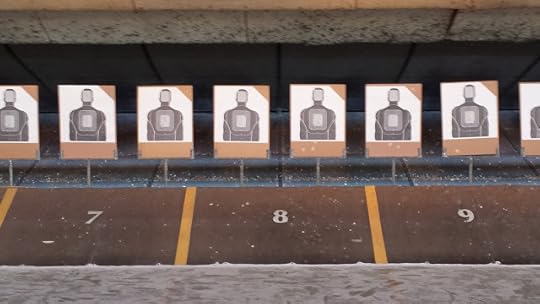 I took the opportunity today to make things go bang and complete my once a year qualification at the police academy shooting range. Since this is the month all retired sworn personnel have to qualify in order to maintain their permit to carry a concealed weapon, there were a number of acquaintances on either side of me along the firing line. I like to fool myself into thinking I can't possibly look as old as they do. Still, trigger fingers were firm, hands were steady, and the bullets all hit the appropriate body mass on the target outlines – not exactly as tight a grouping as back in the day, but it would still get the job done...
I took the opportunity today to make things go bang and complete my once a year qualification at the police academy shooting range. Since this is the month all retired sworn personnel have to qualify in order to maintain their permit to carry a concealed weapon, there were a number of acquaintances on either side of me along the firing line. I like to fool myself into thinking I can't possibly look as old as they do. Still, trigger fingers were firm, hands were steady, and the bullets all hit the appropriate body mass on the target outlines – not exactly as tight a grouping as back in the day, but it would still get the job done...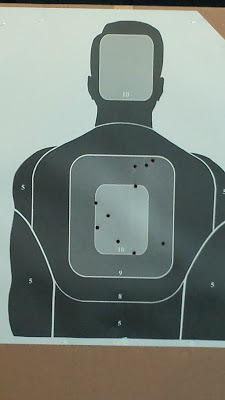
The Davis Academy, where I shot today, only came into existence a few year before I retired. There is also the Manchester Training Center near LAX, which is an even newer facility. The Elysian Park Academy, built on the grounds of the 1932 Olympic Village across from Dodger Stadium, was where I did my time. It is currently undergoing a long overdue facelift, but they will never get rid of the sweat and blood stains left behind by the recruits who went through hell to completed their training there.
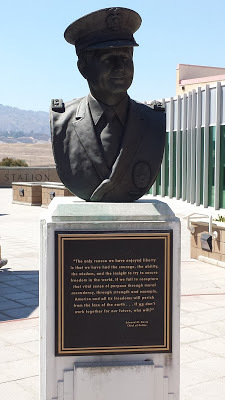
While at the Davis facility today, I saw a class of recruits (Academy Class 4/15) sweating it out on the grinder in their PT gear and 90 degree heat. The sight triggered memories both good and bad of undergoing the same refining process (Academy Class 3/77). They were all young, slim, and wide-eyed. They are going to have to become confident and competent very fast to deal with the harsh decsions awaiting them on the streets of Los Angeles 2015...Frankly, I don't envy them in the least...
Published on August 11, 2015 17:00
CRIME AND SCIENCE RADIO
 Had a blast this morning being given the bright lights and rubber hoses treatment while recording a future episode of Crime and Science Radio hosted by Jan Burke and Dp Lyle...Let's just say a lot of controversy is going to be generated by this conversation...Plus we wedged in a strong plug for my latest novel, Lie Catchers, which will be available by the time the episode airs...
Had a blast this morning being given the bright lights and rubber hoses treatment while recording a future episode of Crime and Science Radio hosted by Jan Burke and Dp Lyle...Let's just say a lot of controversy is going to be generated by this conversation...Plus we wedged in a strong plug for my latest novel, Lie Catchers, which will be available by the time the episode airs...
Published on August 11, 2015 12:48
ONE POLICE DEPARTMENT SPEAKS OUT
 A few days ago, the Holman Police Department in Wisconsin posted a reasonable guideline on their open Facebook page stating, “posts made to this page that contain profanity will be deleted. We promote this page as family friendly. Thank you.”
A few days ago, the Holman Police Department in Wisconsin posted a reasonable guideline on their open Facebook page stating, “posts made to this page that contain profanity will be deleted. We promote this page as family friendly. Thank you.” Public Facebook pages representing and administered by law enforcement entities are unfortunately often the targets of trolls and other foul-mouthed and derogatory individuals. Usually, it is best not to reply to these comments as it often makes the situation worse. However, when someone replied to the Holman PD’s statement about promoting their page as family friendly with a snide comment, the administrator of the Holman PD page responded in a manner that has gone viral over social networking. It is reproduced in its entirety below...
HOLMAN PD
“Recently we posted a request that comments on our Facebook page not contain profanity as we try to promote our page as “family friendly.”
Our post received a comment “Yet police aren’t typically family friendly.”
While our department usually refrains from online squabbles with posters, that comment hit home and deserves a response.
I ask myself why the Holmen Police Department aren’t considered family friendly, but I realize it’s possibly a general perception of police altogether? Either way…
I can understand why you don’t see us as family friendly when someone in a family calls 911 because of a domestic disturbance and someone goes to jail. Maybe that caller was the child watching their parent beaten for the last time and was terrified for that parent’s life. Maybe that caller was the spouse who was scared if they didn’t call that they wouldn’t wake up in the morning. Maybe an outcome of that call was that children had to be removed out of the house, not because it’s something we enjoy doing, but we felt it was our only option at that point because children cannot protect themselves and we had no other alternative. Every officer I know tries everything they can do to NOT to arrest a parent in front of their children, because no matter how reprehensible that parents’ actions were they still have children who look at them through loving eyes that only an innocent child has.
I suppose we’re not family friendly when we arrest someone and remove their children when they’re cooking meth in their home or dealing drugs out of their home while their children play in the next room. I wonder how family friendly the guests are who come into that household to buy the drugs or family focused their parents are when they’re passed out, strung out or paranoid from their drug binges.
The police aren’t family friendly when they have to arrest a parent or other caregiver for abusing a child. At that point it isn’t our job to worry about what the public will think or if the children will hate us because we have to protect the children when those that brought them into this world can’t or aren’t doing their jobs.
We aren’t family friendly when we execute a search warrant on a house where we know someone is possessing child pornography or let’s call it what it really is, children being recorded for gratification while they’re abused, because we need to find out if that suspect is hurting any children in our community.
When we stop someone for speeding or an equipment violation and your children are in the car maybe that “not family friendly” ticket or warning will make you rethink your driving behavior the next time you’re on the road so we don’t see you in a crash with your children in an ambulance or worse.
We try to be compassionate and family friendly as best we can when have to knock on your door to tell you that your loved one has died and try to help you through those first few moments of horrendous grief. It is one of the worst things we have to do as law enforcement officers.
When you call 911 because someone in your family is hurt it is the police who are usually there first trying to calm you and help you. We help call a relative, secure your house or do whatever we can so you can concentrate on your loved one.
If someone is threatening you or your family you call us to protect you and your loved ones. How more family friendly do you expect us to be?
We buy hundreds of pieces of candy for Halloween night handing out to as many kids as we can. In fact we usually have to go hide out once we run out because our community knows our tradition and we are family friendly, well at least on Halloween we are.
Every officer has sacrificed Thanksgivings, Christmases, birthdays and countless other important family events of our own so that we are on duty in case YOU need us to NOT be family friendly on a holiday.
We’ve stopped at daycares for visits, given presentations at schools, given tours of our squads and PD, handed out countless stickers in an effort for children to see that we are family friendly and they should know that we are here to protect them and NOT to fear us. It’s sad your children are probably among the ones that fear us, instead of knowing we’re here to help them. We have people threaten their children in restaurants where we’re eating saying we’ll take them away if they don’t behave. I personally will call you out if you say that and I hear it. Don’t make your children afraid of us, who will be at their door when they call 911 for something and need help? Not you, us.
Most of us have children of our own who we kiss goodbye each day to wear a badge and be a part of a profession that has become so dangerous and hated in the last few years that we wonder why we choose to make that sacrifice for your families, especially since we’re NOT family friendly.
We’ve seen things, horrible things that the general public can’t even begin to wrap their minds around…and we see the outcome of situations that are NOT family friendly. So we’re sorry if your perception of us isn’t that we’re not family friendly, but in my eyes we do a job that is very family friendly and our officers’ care about the community that they serve, especially the children and families.
I have a simple fix to your perception of how we’re NOT family friendly...How about people stop doing things that put us, the police, in situations that aren’t family friendly?”
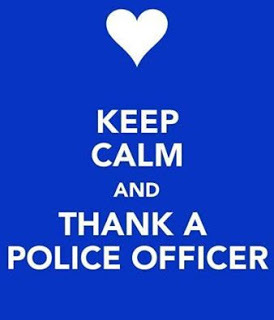 As the LEO AFFAIRS blog stated: Boom. Mic Drop. Elvis has left the building. Congratulations to Holmen PD speaking out...
As the LEO AFFAIRS blog stated: Boom. Mic Drop. Elvis has left the building. Congratulations to Holmen PD speaking out...
Published on August 11, 2015 11:00



